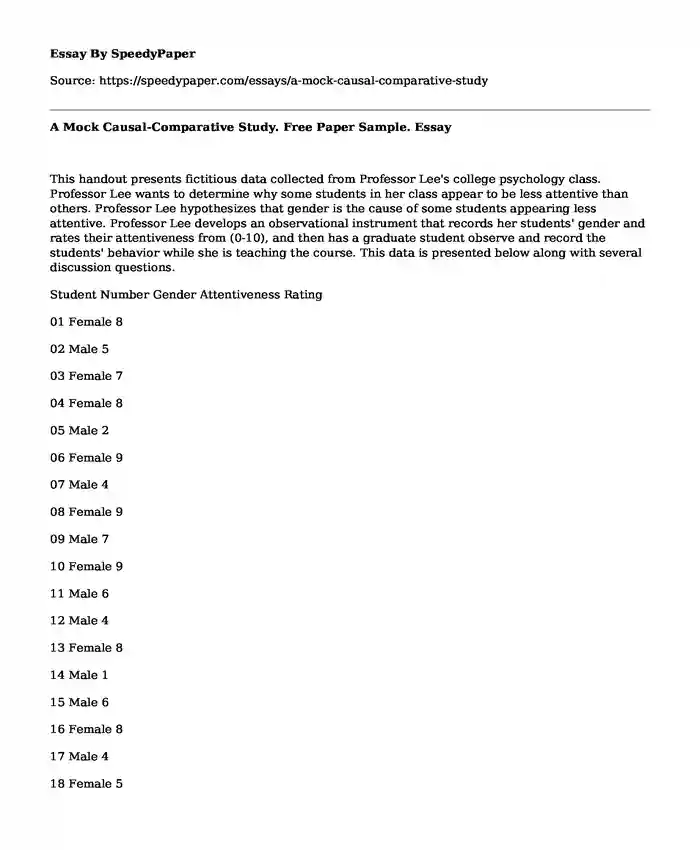
| Type of paper: | Essay |
| Categories: | Education Research Statistics |
| Pages: | 3 |
| Wordcount: | 757 words |
This handout presents fictitious data collected from Professor Lee's college psychology class. Professor Lee wants to determine why some students in her class appear to be less attentive than others. Professor Lee hypothesizes that gender is the cause of some students appearing less attentive. Professor Lee develops an observational instrument that records her students' gender and rates their attentiveness from (0-10), and then has a graduate student observe and record the students' behavior while she is teaching the course. This data is presented below along with several discussion questions.
Student Number Gender Attentiveness Rating
01 Female 8
02 Male 5
03 Female 7
04 Female 8
05 Male 2
06 Female 9
07 Male 4
08 Female 9
09 Male 7
10 Female 9
11 Male 6
12 Male 4
13 Female 8
14 Male 1
15 Male 6
16 Female 8
17 Male 4
18 Female 5
19 Female 8
20 Male 7
Discussion questions:
Which descriptive statistics would you use to analyze and present these data?
The descriptive statistics which I would use to analyze and present the above data include standard deviation, variance, interquartile range, mean, mode and median. I can use mean because it will provide one universal data which represent entire observations. The mode will also be used to indicate the gender which frequently has high attentiveness rating. Median will also be used to show the middle figure of these observations when they are arranged in either ascending or descending order. Standard deviation and variances will be used to describe these observations by showing their skewness. The use of these statistics will also be able to produce good statistical graphs and charts which can be interpreted easily.
Do you think the data support Professor Lee's hypothesis?
The data collected is able to support Professor Lees Hypothesis because these data are able to identify the number of students in a class who are attentive and those who are not attentive based on gender. The same data is also able to provide reliable data based on the behavior of Professor Lees class and this can be used to justify his hypothesis. The data also are able to reflect gender inequality and its effect on the students performance and attentiveness. It could clearly show the level of attentiveness of each gender and frequency of attentiveness. This kind of information is therefore able to support his hypothesis.
What are some reasons that may explain why gender appears to be a cause for lack of attentiveness in Professor Lee's class?
I think gender appears to be one of the causes of lack of attentiveness in Professor Lees class because gender biases in that teachers have cause stereo-typic expectations for most of students achievement and involvement in class activities. Most teachers have perceptions that male students dominate the classroom and also more attentive than female students. This kind of attitude that teachers have even negative impact on the classroom climate hence makes female students to be less attentive. Attentiveness of students in professor Lees class is also affected by gender based discrimination. This kind of discrimination may also affect the attentiveness of some students because they will develop negative attitude towards the subject and the teacher.
Attentiveness of Professors Lees class is also affected by teachers unconscious stereo-type gender bias. This is because teachers believe that male students are smarter than female students in certain subjects such as mathematics and sciences. This will make the teacher to work close with boys in order to find a given solution in either math or science. This will make girls to feel neglected and become less attentive in class.
4) What are some threats to the internal validity of this study and how might they be controlled?
There are a number of threats which may affect internal validity of this study. These threats include cultural background of students, class diversity and teaching methods. Cultural background may make some students to have some behavior that cannot allow them to be active and attentive in class. These cultures include eating in class, listening to music when in class and other unwanted behavior. These kinds of cultural behaviors may make some students to be less attentive. Class diversity is also a threat to this study. Since the class is composed of people from diverse cultural backgrounds, it is very difficult to get correct result because there are some students who may not be affected by gender inequality. Teaching method is also a threat to this study. There are some teaching methods which is able to accommodate all students and influence all students to be attentive in class by engaging all the students. These teaching methods will also contribute in the collection of poor data which does not reflect the true picture of the class.
Cite this page
A Mock Causal-Comparative Study. Free Paper Sample.. (2019, Sep 12). Retrieved from https://speedypaper.net/essays/a-mock-causal-comparative-study
Request Removal
If you are the original author of this essay and no longer wish to have it published on the SpeedyPaper website, please click below to request its removal:
- Research Essay Outline Example: Emancipation
- Free Essay Describing Gain and Loss Effect in Literature
- Research Proposal Paper Sample: Siblings' Relationships
- Compare and Contrast Essay Sample of Herland and The Yellow Wallpaper and Women and Economic
- Paper Example. The Social Innovation Agency
- Essay Sample on Reflection on Technical Writing
- Essay Example. Nursing Case Study, Written Inquiry/Reflection
Popular categories




